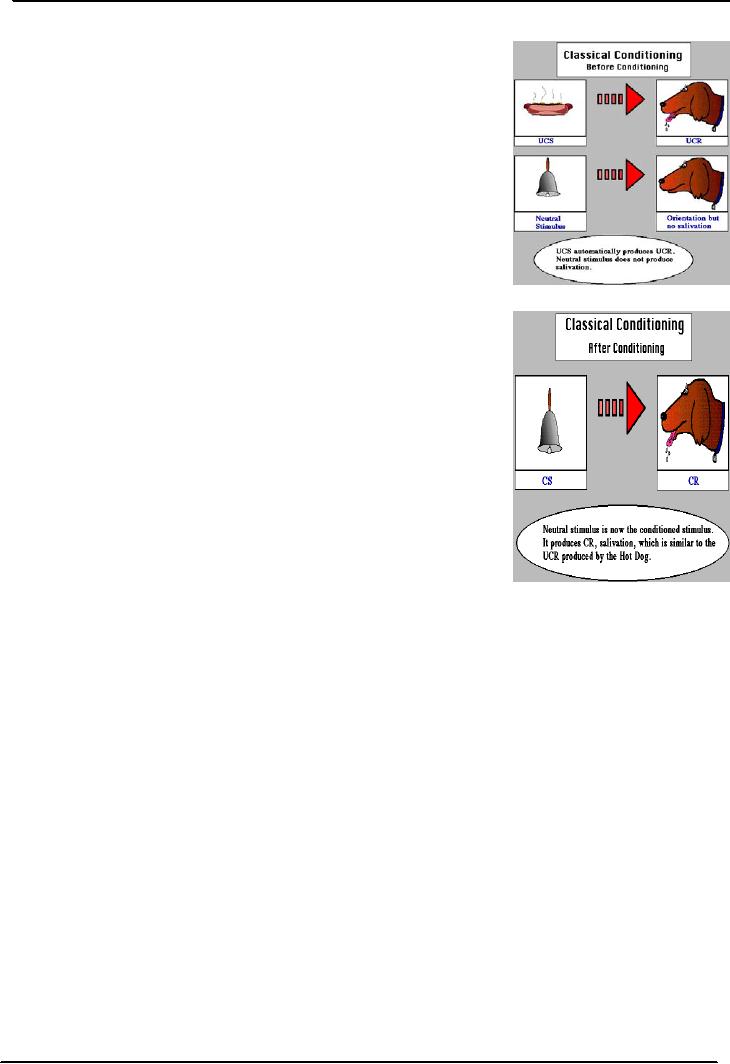 |
BEHAVIORIST PERSPECTIVE AND VIOLENCE:Shadow’s violence, Child’s violence |
| << JUNGIAN PSYCHOLOGY AND VIOLENCE:Religion and mental illnesses |
| BEHAVIORIST PERSPECTIVE AND VIOLENCE:Operant Conditioning >> |

Forensic
Psychology (PSY -
513)
VU
Lesson
13
BEHAVIORIST
PERSPECTIVE AND VIOLENCE
Objectives:
To
understand the concept of archetypal
constellations and
violence
To
understand the scientific theory of
behaviorist perspective
To
understand the classical conditioning and
extinction
Few
topics from previous
lesson
Archetypal
Constellations and Violence
Shadow's
violence
When
shadow is dominant that is
when nations go for war.
Shadow is the bad side of the person
and
person
himself is unaware of this evil side.
Like master minded and
logical leaders of one
country
attacking
other poor countries and justifying
their brutal acts although
the whole world can view
but
such
cruel leaders can not. Wars,
violence epidemics, chaos are the
examples of the manifestations of
shadow.
Child's
violence
Child
wants every thing now and
behaves with out considering
the consequences. So when
ever
obstacles
come in his way, is
frustrated, angry wants some
thing, resort to
violence.
Great
mother's violence
Great
mother's violence except the child is
threatened. Then becomes "Kali
Devi", "Durga Mata"
and
uncover
the sword and even drinks the blood of foes.
She becomes fearsome to
protect love ones.
Hero's
violence
By
nature is a violent figure. Because
always fighting with the
dragon or villain but the
fighting cause is
noble.
Wise
old man's violence
Usually
does not commit violence
but when ever perverted
shows violence in the form of
deceive,
treachery
and betrayal and misguides the hero
and takes a shape of
trickster.
Anima's
violence
Typically
does not commit the violence
but soften the ways to avoid brutality.
Even legitimate
violence
is
required it makes hindrances by creating
weakness.
Animus's
violence
Makes
more violent women perverted
form can commit same
kind of bloodshed as shadow
commits.
Trickster's
violence
Trickster
exhibits extreme kind of aggression
just as shadow shows.
Self's
violence
Self
shows justifiable and holy
violence like "Jihad"
crusade, battle that is take
up only in the name of
Allah
and not only person indulge
in this kind of violence but
also the other people are
convinced too.
When
different archetypes fail to
work in collimating manner, violence
can be a result.
BEHAVIORIST
PERSPECTIVE
Behaviorist
perspective presents the scientific
theory of psychology. they
introduced the ideas in the
field
of psychology that
I.
Man learns just like an
animal
II.
Man behaves just like an
animal
48

Forensic
Psychology (PSY -
513)
VU
The
conjectured if you want some
one to learn some new
material, present that thing
in association with
already
known material. They not
only created a new language
but also a new philosophy
and a new
promise
was made that we can
understand human behaviour by breaking it
into small pieces.
Classical
Conditioning
Classical
conditioning was the first
type of learning to be discovered and studied
within the behaviorist
tradition
(hence the name classical). The
major theorist in the development of
classical conditioning is
Ivan
Pavlov, a
Russian scientist trained in biology and
medicine (as was his
contemporary, Sigmund
Freud).
Pavlov was studying the
digestive system of dogs and
became intrigued with his
observation
that
dogs deprived of food began
to salivate when one of his
assistants walked into the
room. He began
to
investigate this phenomenon and established the laws
of classical conditioning
Major
concepts
Classical
conditioning is Stimulus (s)
----------------Response (R)
conditioning. And the
stimulus
antecedent
stimulus causes the involuntary
response to occur. Classical conditioning
starts with a reflex:
an
innate, involuntary behavior
elicited or caused by an antecedent
environmental event. For
example, if
air
is blown into your eye, you
blink. You have no voluntary or conscious
control over whether the
blink
occurs
or not
Unconditioned
Stimulus leads to Unconditioned
Response.
Conditioned
Stimulus before Unconditioned
Stimulus.
Conditioned
Stimulus leads to Conditioned
Response.
Un
Conditioned Stimulus---- Un Conditioned
Response
Un
Conditioned Stimulus---- Conditioned
Stimulus -----Unconditioned
Response
(Repetition)
Conditioned
Stimulus Conditioned
Response.
The
specific model for classical conditioning
is:
1.
Unconditioned Stimulus (US)
elicits ---------- Unconditioned
Response (UR):
A
stimulus will naturally
(without learning) elicit or
bring about a reflexive
response
2.
Neutral Stimulus
(NS)------------------does not elicit the
response of interest
This
stimulus (sometimes called an
orienting stimulus as it elicits an
orienting response) is a
neutral
stimulus
since it does not elicit the
Unconditioned (or reflexive)
Response.
3.
The Neutral Stimulus (NS) is
repeatedly paired with the
Unconditioned/Natural Stimulus
(US).
4.
The NS is transformed into a Conditioned
Stimulus (CS)
That
is, when the CS is presented by itself,
it elicits or causes the CR (which is the
same
involuntary
response as the UR
The
name changes because it is
elicited by a different stimulus. This is written CS
elicits >
CR.
In
classical conditioning no new
behaviors are learned.
Instead, an association is developed
(through
pairing)
between the NS and the US so that the animal /
person responds to both
events
The
following is a restatement of these
basic principles using figures of
Pavlov's original
experiments
as an example.
49

Forensic
Psychology (PSY -
513)
VU
Before
conditioning
In
order to have classical or respondent
conditioning, there must exist
a
stimulus
that will automatically or
reflexively elicit a specific
response.
This
stimulus is called the Unconditioned
Stimulus or UCS because
there
is
no learning involved in connecting the
stimulus and response.
There
must
also be a stimulus that will
not elicit this specific
response, but will
elicit
an orienting response. This
stimulus is called a Neutral
Stimulus.
During
conditioning
During
conditioning, the neutral stimulus
will first be
presented,
followed
by the unconditioned stimulus. Over
time, the learner
will
develop
an association between these two stimuli
(i.e., will learn to
make
a
connection between the two
stimuli.
After
conditioning
After
conditioning, the previously neutral or
orienting stimulus will
elicit
the
response previously only
elicited by the unconditioned stimulus.
The
stimulus
is now called a conditioned
stimulus because it will now
elicit a
different
response as a result of conditioning or
learning. The response
is
now
called a conditioned response
because it is elicited by a stimulus
as
a
result of learning. The two
responses, unconditioned and
conditioned,
look
the same, but they are
elicited by different stimuli and
are therefore
given
different labels.
Classical
conditioning primarily influences
our emotional
behavior.
Things
that make us happy, sad,
angry, etc. become
associated with
neutral
stimuli that gain our
attention. All of our childhood
learning is
voluntary
for instance a person likes
green color this could be the
result
of
an association of a nice guest, who show
tenderness and always
come
wearing
green colour.
But
the question is how people
learn to hurt other and
become violent? How
childhood learning can
get
connected
to other adult behaviors.
Pavlov concluded that if an animal
learn in this way the man
must
learn
in the same way.
"How
we forget" issue
Only
tangibles are the subject matter of
behaviorists and forgetting is a relevant
to memory.
Behaviorists
subjected the issue of forgetting in the
same way.
Extinction
Extinction
refers to the weakening/elimination of a CR when the
CS is no longer followed by the
UCS.
Elimination
of the conditioned response by repeatedly
presenting the conditioned stimulus
without the
unconditioned
stimulus- for example,
repeatedly rings of bell
without presenting food
afterward.
Pavlov
explained the phenomena of forgetting by
extinction. So, Major
concepts of extinction
are
Conditioned
Stimulus No Un Conditioned Stimulus
(Repetition)
Conditioned
Stimulus No Conditioned
Response
50
Table of Contents:
- INTRODUCTION TO FORENSIC PSYCHOLOGY:Future of Forensic Psychology
- INTRODUCTION TO FORENSIC PSYCHOOGY:Way of police investigation
- FORENSIC PSYCHOLOGY AND POLICE:Violent Criminals
- POLICE PSYCHOLOGY:Use of excessive force, Corruption, Personnel Selection
- POLICE PSYCHOLOGY:Fitness-for-Duty Evaluation (FFDE), False Confessions
- INVESTIGATIVE PSYCHOLOGY:For instance, Empirical and logical approach
- INVESTIGATIVE PSYCHOLOGY:Crime Scene Investigation, Staging
- PSYCHOLOGY OF VIOLENCE:Law of Conservation of Energy, Super ego
- PSYCHOANALYTIC MODEL AND VIOLENCE:Fixation at Oral Stage
- PSYCHOANALYTIC MODEL AND VIOLENCE:Defense Mechanism, Rationalization
- JUNGIAN PSYCHOLOGY AND VIOLENCE:Freudian Methods, JUNGIAN PSYCHOLOGY
- JUNGIAN PSYCHOLOGY AND VIOLENCE:Religion and mental illnesses
- BEHAVIORIST PERSPECTIVE AND VIOLENCE:Shadow’s violence, Child’s violence
- BEHAVIORIST PERSPECTIVE AND VIOLENCE:Operant Conditioning
- BEHAVIORIST PERSPECTIVE AND VIOLENCE:Schedules of Punishment
- SOCIAL LEARNING MODEL AND VIOLENCE:Observational learning, Vicarious punishment
- MORAL DEVELOPMENT AND VIOLENCE:Symbolic functioning, Formal operational stage
- BIO-PSYCHO-SOCIAL MODEL:Mental hospitals are factories of abuse
- ISLAMIC PERSPECTIVE ABOUT VIOLENCE:Morality is essential
- ISLAMIC MODEL:Nafs al-Ammara, Nafs al-Lawwama, Nafs ul Naatiqa
- TREATMENTS FOR THE SOUL:Tawba, Sabr o Shukr, Niyyat o Ikhlaas, Taffakkur
- CRIMINOGENIC PERSONALITY:Personality Disorders, Common Crimes
- CRIMINOGENIC PERSONALITY AND VIOLENCE:Mnemonic, Similarities
- CRIMINOGENIC PERSONALITY AND VIOLENCE:Terrorism and Psychopaths
- LEARNING DISABILITIES/MENTAL RETARDATION AND VIOLENCE
- ASSESSMENT OF PERSONALITY DISORDERS:Reasons for referral, Personality Inventories
- ASSESSMENT OF PERSONALITY DISORDERS:Different cutoff scores
- RISK ASSESSMENT:Violence reduction scale, Stability of Family upbringing
- TREATMENT OF VIOLENT BEHAVIOR / PERSONALITY PSYCHODYNAMIC PSYCHOTHERAPY
- JUNGINA THERAPEUTIC MODEL:Limits of re-parenting, Personality Typologies
- GROUP THERAPY FOR OFFENDERS:Learning in Groups, Humanistic Groups
- PSYCHOTHERAPIES IN FORENSIC SETTINGS:Narrative Therapy
- PSYCHOTHERAPIES IN FORENSIC SETTINGS:Solution Focused Therapy
- PSYCHOTHERAPIES IN FORENSIC SETTINGS:Avoiding reactance, Externalization
- PSYCHOTHERAPY IN FORENSIC SETTINGS AND SPECIAL CHALLENGES
- FORENSIC PSYCHOTHERAPY:Exploring therapeutic alliance, Music Therapy
- VIOLENCE REDUCTION PROGRAM:Target Population, Lack of motivation
- VIOLENCE REDUCTION PROGRAM:Criminal attitude, Interpersonal Aggression
- VICTIM SUPPORT:Main features of PTSD, Emotional Support
- VICTIM SUPPORT:Debriefing, Desensitization, Eidetic Therapy, Narrative Therapy
- SUBSTANCE MISUSE TREATMENT PROGRAM:Marijuana, Unconventional drugs
- SUBSTANCE MISUSE TREATMENT PROGRAM:Stages of Change, Homosexuality
- EXPERT WITNESS:Insanity Pleas, Sexual Offence Risk, Instructions
- COUNTER TERRORISM:Misconceptions, Psychologists & Propaganda war
- SUMMING UP FORENSIC PSYCHOLOGY:Problems with Risk Assessment, Expert Witness